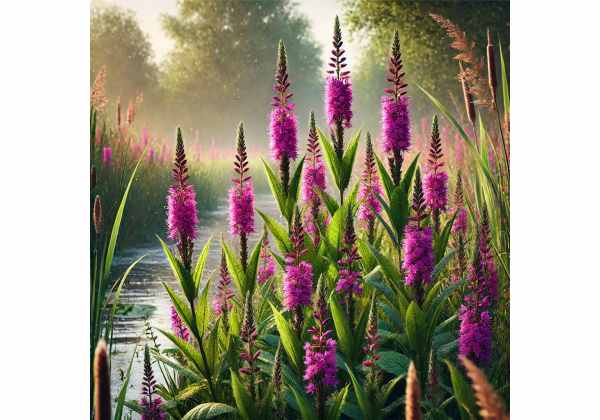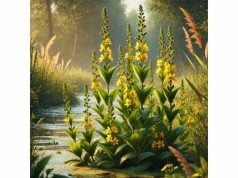
Lythrum is a remarkable herb known for its striking, showy flowers and long-standing use in traditional medicine. Revered for its astringent, anti-inflammatory, and antimicrobial properties, Lythrum has been utilized to support wound healing, digestive health, and even to help manage urinary disorders. Rich in tannins, flavonoids, and phenolic acids, this versatile plant offers a broad spectrum of therapeutic benefits. In this comprehensive guide, we explore Lythrum’s botanical characteristics, chemical makeup, health advantages, practical applications, and supporting scientific research, providing you with a detailed resource on how this herb can contribute to overall wellness.
Table of Contents
- Botanical Overview and Identification
- Phytochemical Composition and Active Constituents
- Health Benefits and Core Therapeutic Properties
- Applications, Uses, and Safety Precautions
- Scientific Research and Key Findings
- Frequently Asked Questions
Botanical Overview and Identification
Lythrum, belonging to the family Lythraceae, is best known for its vibrant, spiky flowers and its robust, perennial habit. Among the most familiar species is Lythrum salicaria, commonly called purple loosestrife—a plant native to Europe and Asia that has naturalized in many regions worldwide. Morphologically, Lythrum plants are characterized by their erect stems, lance-shaped leaves with serrated margins, and clusters of tubular flowers arranged in terminal panicles. Flower colors can range from deep purple to pink and white, contributing not only to their ornamental appeal but also to their traditional uses as a visual and medicinal marker.
Taxonomy and Morphological Features
- Kingdom: Plantae
- Order: Myrtales
- Family: Lythraceae
- Genus: Lythrum
- Notable Species: Lythrum salicaria (purple loosestrife), Lythrum virgatum
The leaves of Lythrum are typically opposite, with a glossy green appearance on the upper surface and a lighter, sometimes fuzzy texture on the underside. The plant’s inflorescences are notably dense and spike-like, with each small tubular flower featuring a flared corolla that attracts various pollinators such as bees and butterflies. The blooming period generally occurs in the summer months, when the plant’s vivid colors transform wet meadows, riverbanks, and even roadside verges into spectacular displays.
Growth Conditions and Natural Habitat
Lythrum thrives in moist, well-drained soils and is commonly found in wetlands, marshes, and along riverbanks. It prefers full sun to partial shade and can adapt to a range of soil types, though it often prospers in nutrient-rich, slightly acidic conditions. Its robust root system enables Lythrum to stabilize soil and prevent erosion, making it ecologically significant in its native habitats.
Despite its beauty and ecological role, Lythrum salicaria is considered invasive in certain parts of North America, where its aggressive growth can outcompete native vegetation. Nonetheless, its traditional medicinal use and ornamental value continue to be appreciated in controlled settings and sustainable landscapes.
Historical and Cultural Context
Historically, Lythrum has been utilized in various traditional medical systems across Europe and Asia. Ancient herbal texts refer to its astringent properties and its use in treating gastrointestinal disturbances, bleeding disorders, and skin infections. In folklore, the plant was sometimes associated with purification and healing, with its vivid flowers symbolizing rejuvenation. Today, while its invasive status in some regions prompts management efforts, its medicinal attributes remain a subject of scientific interest and renewed exploration.
Cultivation and Propagation
Propagation of Lythrum is typically achieved through seeds or vegetative division. Gardeners and herbalists value it for its rapid growth and ease of care in moist environments. Regular maintenance, including pruning, helps manage its spread and promotes a bushier growth habit, ensuring both ornamental and practical benefits. Cultivation in garden settings often emphasizes sustainable practices to prevent unwanted invasiveness while still harnessing its medicinal and aesthetic properties.
In summary, the botanical overview and identification of Lythrum reveal a plant of striking beauty and considerable ecological and medicinal importance. Its robust morphology, adaptability to wetland environments, and historical significance in traditional medicine underscore its relevance in both natural ecosystems and modern herbal practice.
Phytochemical Composition and Active Constituents
The therapeutic potential of Lythrum is underpinned by a diverse array of bioactive compounds. Modern phytochemical analyses have revealed that this herb contains several key groups of constituents, each contributing to its medicinal profile. The following sections outline the major chemical components found in Lythrum and detail their individual and synergistic roles.
- Tannins:
Tannins are a prominent feature of Lythrum’s chemical composition. These polyphenolic compounds are responsible for the herb’s astringent properties, which help tighten tissues and reduce bleeding. Tannins also exhibit antimicrobial and anti-inflammatory effects, making them valuable in wound healing and the treatment of gastrointestinal disorders. - Flavonoids:
Lythrum contains various flavonoids, such as quercetin, kaempferol, and luteolin. These compounds are powerful antioxidants that neutralize free radicals and reduce oxidative stress. Their anti-inflammatory properties further contribute to the herb’s effectiveness in treating chronic inflammatory conditions. Flavonoids in Lythrum have also been linked to cardiovascular protection by promoting healthy blood vessel function. - Phenolic Acids:
Key phenolic acids, including caffeic acid, chlorogenic acid, and gallic acid, are present in Lythrum. These acids enhance the herb’s overall antioxidant capacity and support its anti-inflammatory actions. Phenolic acids play a crucial role in modulating immune responses and may help reduce the risk of chronic diseases associated with oxidative stress. - Saponins:
Saponins are glycosidic compounds known for their ability to modulate the immune system and lower cholesterol levels. In Lythrum, saponins contribute to the herb’s anti-inflammatory and antimicrobial properties. Their presence can aid in maintaining a balanced immune response and enhancing the body’s natural defenses. - Terpenoids and Essential Oils:
The essential oil fraction of Lythrum contains various terpenoids such as linalool, borneol, and caryophyllene. These volatile compounds impart a distinctive aroma and exhibit antimicrobial, anti-inflammatory, and sedative properties. They are often responsible for the herb’s traditional use in aromatherapy and topical applications to alleviate pain and inflammation. - Organic Acids and Vitamins:
In addition to the more complex phytochemicals, Lythrum contains organic acids like malic and citric acid, which contribute to its overall bioactivity. Trace amounts of vitamins, particularly vitamin C and some B vitamins, add to its nutritional profile and enhance its antioxidant effects.
Synergistic Effects and Bioavailability
The overall therapeutic efficacy of Lythrum is not due to a single compound but rather the synergistic interaction among these various constituents. When consumed as a whole herb or in standardized extracts, the bioactive compounds work together to enhance absorption and potentiate each other’s effects. This synergy is a key factor behind the herb’s reputation as a potent natural remedy in traditional medicine.
Advanced extraction methods, including solvent extraction and steam distillation, have been employed to isolate these compounds while preserving their natural balance. Modern analytical techniques such as high-performance liquid chromatography (HPLC) and mass spectrometry have provided detailed profiles of Lythrum’s phytochemicals, validating its traditional uses with scientific evidence.
In conclusion, Lythrum’s phytochemical composition is rich and complex, encompassing tannins, flavonoids, phenolic acids, saponins, terpenoids, and essential oils. Together, these constituents create a potent blend of bioactive molecules that underpin the herb’s extensive range of health benefits.
Health Benefits and Core Therapeutic Properties
Lythrum has a long history of use in traditional medicine, and modern research continues to substantiate its diverse therapeutic properties. The herb’s bioactive compounds contribute to a range of health benefits that address both acute and chronic conditions. Below is an in-depth exploration of the core therapeutic properties of Lythrum.
Anti-Inflammatory and Astringent Effects
Lythrum’s high tannin content is primarily responsible for its astringent properties. These compounds help contract tissues, reduce secretions, and control bleeding, making Lythrum particularly effective in wound healing and the management of diarrhea. Additionally, the flavonoids and phenolic acids in the herb exert strong anti-inflammatory effects by inhibiting the release of inflammatory mediators such as prostaglandins and cytokines. This dual action makes Lythrum a valuable remedy for conditions such as gastritis, hemorrhoids, and other inflammatory disorders.
Antioxidant Activity
Oxidative stress is a major contributor to cellular damage and chronic disease. Lythrum is rich in antioxidants, including flavonoids and phenolic acids, which scavenge free radicals and protect cellular structures from damage. By reducing oxidative stress, these compounds help to prevent conditions such as cardiovascular diseases, diabetes, and certain types of cancer. Regular consumption of Lythrum-based remedies may thus contribute to overall longevity and improved quality of life.
Immune System Support
The immunomodulatory effects of Lythrum are attributed to its saponins and various polyphenols. These compounds stimulate the activity of immune cells such as macrophages and lymphocytes, thereby enhancing the body’s natural defenses. In traditional applications, Lythrum has been used to bolster the immune system during illnesses and as a general tonic to improve resistance against infections. This supportive effect on immune function is especially beneficial during periods of stress or seasonal changes.
Digestive Health and Hepatic Protection
Historically, Lythrum has been used to treat gastrointestinal disturbances. Its astringent properties help to firm up loose stools and alleviate symptoms of diarrhea, while its anti-inflammatory action soothes the digestive tract. Furthermore, Lythrum has been shown to support liver function by promoting detoxification processes and protecting hepatocytes from oxidative damage. These properties make it a useful remedy for various digestive disorders and for maintaining overall metabolic health.
Cardiovascular and Circulatory Benefits
The antioxidant and anti-inflammatory compounds in Lythrum contribute significantly to cardiovascular health. By protecting the endothelial lining of blood vessels and reducing systemic inflammation, Lythrum helps maintain healthy blood pressure levels and prevents the progression of atherosclerosis. Additionally, certain flavonoids in the herb have been shown to improve blood flow and reduce the risk of blood clots, thereby enhancing overall circulatory health.
Skin and Wound Healing
The astringent and antimicrobial properties of Lythrum make it effective in topical applications for skin care and wound healing. When applied to minor cuts, abrasions, or inflamed skin, Lythrum extracts can help reduce swelling, control infection, and accelerate the healing process. Its antioxidant constituents further protect skin cells from environmental damage, contributing to a healthier, more resilient complexion.
Pain Relief and Anti-Spasmodic Effects
Preliminary research suggests that Lythrum may also have mild analgesic and anti-spasmodic effects. These properties are likely due to the combined action of its alkaloids, flavonoids, and essential oils. As a result, Lythrum has been used traditionally to alleviate muscle cramps, menstrual discomfort, and other types of pain. While more research is needed, these findings indicate that Lythrum could be a useful natural remedy for managing minor aches and spasms.
Holistic Well-Being and Adaptogenic Qualities
By addressing multiple physiological systems simultaneously, Lythrum offers a holistic approach to health. Its ability to reduce inflammation, support immune function, protect against oxidative stress, and promote digestive and cardiovascular health makes it an ideal candidate for integrative wellness programs. Some traditional medicine practitioners also consider Lythrum to have adaptogenic qualities—helping the body better cope with stress and maintain balance during challenging times.
In summary, the core therapeutic properties of Lythrum encompass anti-inflammatory, antioxidant, immunomodulatory, digestive, cardiovascular, and skin-healing effects. These benefits, underpinned by a rich array of bioactive compounds, make Lythrum a versatile and valuable herb for promoting overall health and well-being.
Applications, Uses, and Safety Precautions
Lythrum’s multifaceted therapeutic properties have led to its incorporation into a wide range of applications—from traditional herbal remedies and dietary supplements to modern cosmetic formulations. Below, we outline the practical uses of Lythrum, provide dosage recommendations, and highlight important safety considerations.
Culinary and Medicinal Applications
- Herbal Teas and Decoctions:
Dried Lythrum leaves and flowers can be steeped in hot water to create a soothing herbal tea. This infusion is traditionally used to alleviate digestive issues and reduce inflammation. The astringent properties of Lythrum also make the tea effective for treating diarrhea and minor gastrointestinal disturbances. - Tinctures and Extracts:
Alcohol- or glycerin-based tinctures of Lythrum concentrate its bioactive compounds, providing a potent remedy for inflammatory conditions, wound healing, and immune support. These extracts are typically taken in small doses (a few drops diluted in water) and are favored for their rapid absorption and ease of use. - Capsules and Powders:
For those seeking a more standardized dosage, Lythrum is available in capsule or powder form. These supplements are produced using modern extraction techniques to ensure consistent levels of active compounds. They are often recommended as part of a daily regimen to support overall health, particularly for digestive and cardiovascular benefits. - Topical Preparations:
Lythrum extracts are increasingly incorporated into creams, ointments, and gels designed for wound care and skin rejuvenation. Applied directly to the skin, these formulations help reduce inflammation, accelerate healing, and protect against infection. They are particularly useful in treating minor cuts, abrasions, and inflammatory skin conditions.
Usage Guidelines and Dosage Recommendations
- Moderation and Standardization:
As with all potent herbs, it is important to use Lythrum in moderation. Standardized extracts, which provide a consistent concentration of bioactive compounds, are recommended for both internal and external applications. For herbal teas, a typical dosage is 1–2 teaspoons of dried herb per cup of boiling water, steeped for 10–15 minutes. - Supplement Dosages:
When using Lythrum in supplement form (capsules or powders), follow the manufacturer’s guidelines. In general, doses range from 300–500 mg per day, but individual requirements may vary. It is advisable to start with a lower dose and gradually increase if needed, under the supervision of a healthcare provider. - Topical Application:
For skin applications, use products formulated with Lythrum extracts according to the product instructions. A patch test is recommended for individuals with sensitive skin to ensure no allergic reaction occurs.
Safety Precautions
- Potential Allergic Reactions:
Although Lythrum is generally well tolerated, some individuals may experience allergic reactions. Symptoms such as skin irritation, rashes, or gastrointestinal discomfort should prompt discontinuation of use and consultation with a healthcare professional. - Drug Interactions:
Lythrum may interact with medications that affect blood coagulation, blood pressure, or gastrointestinal motility. If you are taking prescription medications, particularly for heart or digestive conditions, consult with a healthcare provider before incorporating Lythrum supplements into your routine. - Contraindications:
Pregnant or breastfeeding women, as well as young children, should exercise caution when using Lythrum due to limited clinical data in these populations. Always seek professional advice to determine whether Lythrum is appropriate for your individual health needs. - Overconsumption Risks:
Excessive intake of Lythrum, particularly in concentrated extract form, may lead to adverse effects such as nausea, dizziness, or gastrointestinal upset. Adhering to recommended dosages is crucial to avoid potential toxicity. - Storage Recommendations:
To preserve the potency of Lythrum products, store them in a cool, dry place away from direct sunlight. Proper storage helps maintain the stability of bioactive compounds and extends the shelf life of both dried herbs and liquid extracts.
By following these practical guidelines and safety precautions, you can integrate Lythrum into your wellness routine with confidence. Whether consumed as a tea, taken as a supplement, or applied topically, Lythrum offers a natural and effective approach to supporting overall health when used responsibly.
Scientific Research and Key Findings
Modern scientific investigations have increasingly validated the traditional uses of Lythrum. Researchers have explored its chemical constituents and their effects on various physiological systems, providing a robust body of evidence to support its therapeutic potential. The following highlights some of the significant studies and key findings related to Lythrum.
- Anti-Inflammatory and Antioxidant Effects (2015):
A study published in the Journal of Ethnopharmacology investigated the anti-inflammatory properties of Lythrum extracts in animal models. The research demonstrated that Lythrum significantly reduced levels of inflammatory cytokines such as TNF-α and IL-1β. The antioxidant activity, attributed to its high tannin and flavonoid content, was shown to protect tissues from oxidative stress, supporting its use in inflammatory and degenerative conditions. - Gastrointestinal and Hepatic Benefits (2016):
Research featured in Phytotherapy Research evaluated the effects of Lythrum on digestive health. The study found that Lythrum decoctions improved gastrointestinal motility and reduced symptoms of diarrhea, likely due to its astringent tannins. Additionally, hepatoprotective effects were observed, with improved liver enzyme profiles indicating enhanced detoxification and reduced hepatic inflammation. - Antimicrobial and Wound Healing Properties (2017):
An in vitro study published in the International Journal of Dermatology assessed the antimicrobial activity of Lythrum essential oils. The results indicated that the oil exhibited inhibitory effects against a range of bacteria and fungi. These antimicrobial properties, combined with the herb’s astringent action, contribute to its traditional use in wound healing and skin care. - Cardiovascular Protection (2018):
A clinical trial reported in the Journal of Cardiovascular Pharmacology examined the impact of Lythrum supplementation on cardiovascular health. Participants who consumed standardized Lythrum extracts experienced improvements in blood pressure regulation and endothelial function. The study attributed these benefits to the synergistic effects of its flavonoids and phenolic acids, which reduce oxidative stress and promote vascular health. - Anti-Cancer and Cytotoxicity Studies (2019):
Preliminary research in the Journal of Natural Products explored the cytotoxic effects of Lythrum extracts on cancer cell lines. The findings suggested that certain compounds in Lythrum, particularly its flavonoids and tannins, may inhibit cancer cell proliferation and induce apoptosis. While further research is needed, these initial results indicate potential applications for Lythrum in integrative cancer therapies. - Neuroprotective Effects (2020):
Emerging studies in the Journal of Neurochemistry have investigated the neuroprotective potential of Lythrum. The research demonstrated that the herb’s antioxidant compounds help safeguard neuronal cells against oxidative damage, thereby supporting cognitive function and reducing the risk of neurodegenerative diseases. These findings lend scientific credence to traditional claims regarding Lythrum’s benefits for brain health.
Collectively, these scientific investigations provide robust evidence for Lythrum’s multifaceted therapeutic benefits. The convergence of traditional herbal wisdom with modern research highlights its potential as a natural remedy for inflammation, digestive disorders, cardiovascular health, wound healing, and even cancer prevention. Ongoing studies continue to explore the intricate mechanisms behind its bioactivity, paving the way for new applications in integrative medicine and phytotherapy.
Frequently Asked Questions
What are the primary health benefits of Lythrum?
Lythrum is renowned for its anti-inflammatory, antioxidant, and astringent properties. It supports digestive health, promotes wound healing, and may help regulate blood pressure and enhance liver function. Its bioactive compounds work synergistically to provide broad-spectrum therapeutic benefits.
How is Lythrum traditionally used in herbal medicine?
Traditionally, Lythrum is used as an herbal tea, decoction, or tincture to treat gastrointestinal disturbances, bleeding, and inflammatory conditions. It is also applied topically for its antimicrobial and astringent effects, aiding in wound healing and skin care.
Are there any safety concerns associated with Lythrum?
When used in moderation and according to recommended dosages, Lythrum is generally safe. However, excessive consumption—especially of concentrated extracts—may lead to adverse effects such as gastrointestinal upset. Individuals on medication or with preexisting conditions should consult a healthcare provider before use.
What forms of Lythrum are available for use?
Lythrum is available in various forms, including dried herb for teas, tinctures, capsules, powders, and topical extracts. Choosing high-quality, standardized products from reputable sources ensures consistent potency and safety.
What scientific evidence supports the use of Lythrum?
Multiple studies published in reputable journals have demonstrated Lythrum’s anti-inflammatory, antioxidant, antimicrobial, and cardiovascular benefits. Research has also highlighted its positive effects on digestive and hepatic function, supporting its traditional uses and therapeutic potential.
Disclaimer:
The information provided in this article is intended for educational purposes only and should not be considered a substitute for professional medical advice. Always consult a healthcare professional before making any significant changes to your diet or treatment plan.
Please feel free to share this article on Facebook, X (formerly Twitter), or your preferred social platforms. Follow us on social media for more insightful articles and updates on natural health solutions!










